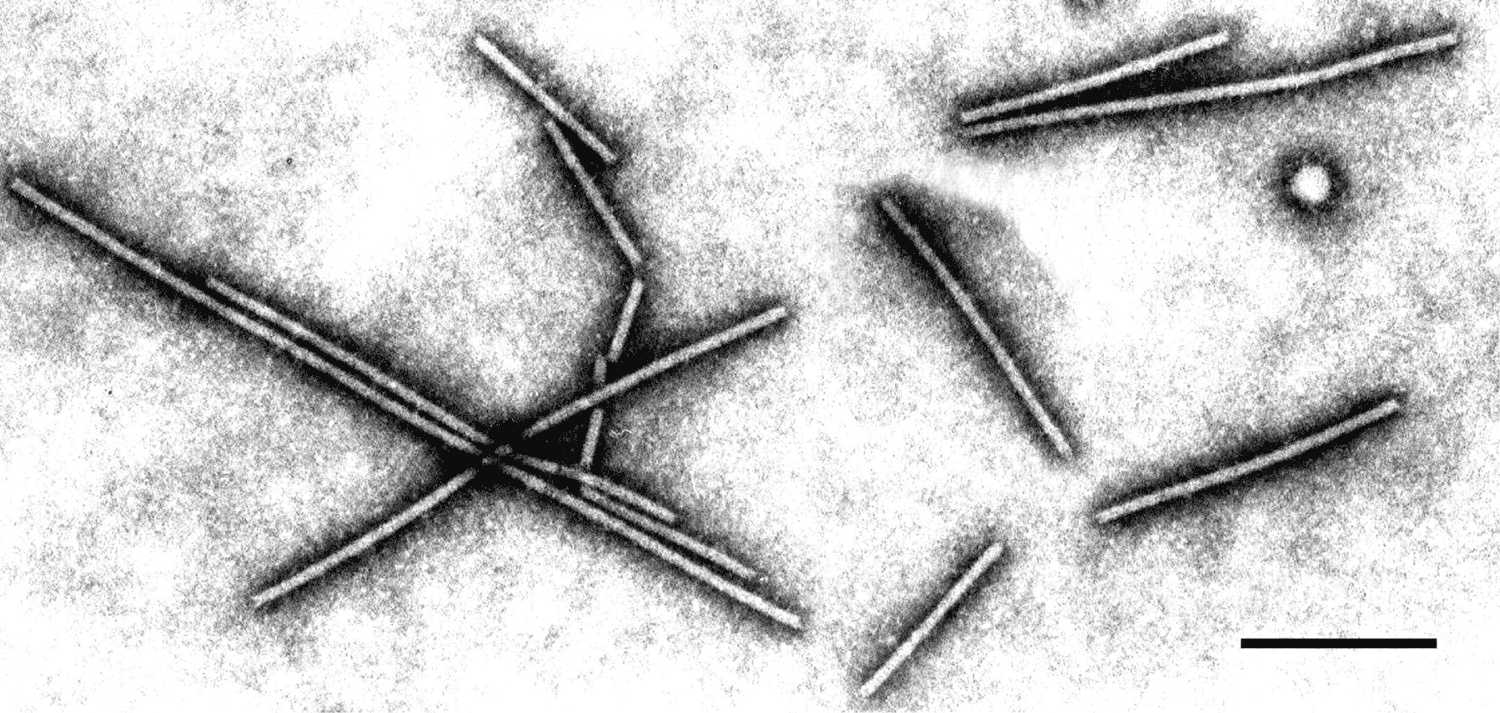Family: Potyviridae
Genus: Bymovirus
Distinguishing features
Compared with other viruses in the family, members of the genus Bymovirus are distinct in having a divided (bipartite) genome and in being transmitted by the root-infecting parasite, Polymyxa graminis (Plasmodiophorales), a fungoid protist.
Virion
Morphology
Virions are flexuous filaments of two modal lengths, 250–300 nm and 500-600 nm; both are 13 nm in width (Figure 1.Bymovirus).
| Figure 1.Bymovirus. Virions of an isolate of barley yellow mosaic virus, stained with 1% PTA, pH 7.0. The bar represents 200 nm (from D. Lesemann). |
Physicochemical and physical properties
Virion density in CsCl is 1.28–1.30 g cm−3.
Nucleic acid
Virions contain two molecules of linear positive-sense, ssRNA. RNA1 is 7.2–7.6 kb and RNA2 is 2.3–3.7 kb (Figure 2.Bymovirus); RNA makes up 5% by weight of particles. There is little sequence identity between the two RNAs except in the 5′-untranslated regions.
 |
| Figure 2.Bymovirus. Schematic diagram of the bymovirus bipartite genome, using, as an example an isolate of barley yellow mosaic virus. Conventions are as for potyvirus genome organization map (Figure 2.Potyviridae). Function of most mature proteins are postulated by analogy with members of the genus Potyvirus. P1 corresponds to the C-terminal protease of HC-Pro. Not to scale. |
Proteins
Virions have a single coat (capsid) protein (CP) of 28.5–33 kDa. The CP of barley yellow mosaic virus isolates has 297 aa.
Genome organization and replication
The two RNA molecules are translated initially into precursor polypeptides from which functional proteins are derived by proteolytic processing (Figure 2.Bymovirus). The organization of RNA1 is similar to that of other potyviruses but without the P1 and HC-Pro proteins. The RNA2 polyprotein is unique to bymoviruses although the first protein encoded by RNA2 (P1, ca. 28 kDa) has aa domains with sequence similarities to the potyvirus protein HC-Pro. The larger protein of RNA2 (P2) is believed to have a role in vector transmission (You and Shirako 2010).
Biology
Cytology
There are characteristic pinwheel-like inclusions and membranous network structures are formed in the cytoplasm of infected plant cells. No nuclear inclusions are found.
Host range
The host range of bymoviruses is narrow, restricted to the host family Poaceae. Each member has a very restricted host range; for example, the barley-infecting viruses do not infect wheat and vice versa.
Transmission
Bymoviruses are transmitted by Polymyxa graminis in a persistent manner, surviving in resting spores as long as these remain viable; they are transmissible experimentally by mechanical inoculation, sometimes with difficulty.
Antigenicity
The viral proteins are moderately immunogenic; apart from barley mild mosaic virus, most members of the genus are serologically related. The CP aa sequence identity among members is 35–74%.
Species demarcation criteria
See discussion under family description.
Related, unclassified viruses
|
Virus name |
Accession number |
Virus abbreviation |
|
soybean leaf rugose mosaic virus |
SLRMV |
Virus names and virus abbreviations are not official ICTV designations.
* incomplete RNA1 genome sequence


